Comparison of Pollutants Emission for Hybrid Aircraft with Traditional and Multi-Propeller Distributed Propulsion
Abstract
1. Introduction
2. Research Aims, Description of the Research Object and Applications of Distributed Propulsion
2.1. Research Aims and Research Object Description
2.2. Materials and Methods
2.3. Application of Distributed Propulsion and Its Analysis in Reference to Traditional Propulsion
- –
- Air speed entering the propeller equal to the flight speed V = 100 km/h (27.78 m/s);
- –
- Propeller operation parameters according to calculation values, i.e., rotational speed n = 5400 rpm, design propeller thrust P = 21 N;
- –
- Parameters of the air surrounding the aircraft for an altitude of 500 m (pressure pH and temperature TH), air density = 1.2 kg/m3;
- –
- Simplification of the propeller geometry to minimize the possibility of numerical errors;
- –
- The finite volume mesh consisted of tetrahedral elements (TED-4) [22], the size of the mesh elements was from 0.2 mm to 50 mm, the minimum size of the mesh resulted from the smallest width of the propeller edge was 0.2 mm.
- –
- Adopting the assumed geometrical system of the propulsion,
- –
- Adopting the same propeller stream velocity distribution, parameters of the flight, and the air surrounding the plane as for the propeller analysis.
- –
- drag force:
- –
- lift force:
- –
- power required for flight:
- –
- power generated by the power unit:
3. Exhaust Composition Analysis
- –
- The engine should be at operating temperature, in the case of the tested engine, it is the thermostat opening temperature of 87.5 °C;
- –
- The engine operation range corresponds to the generator operation range (3500–4000 rpm);
- –
- The engine operating conditions should be as close to the real ones as possible (ambient conditions at cruising altitude).
- –
- Preparation of the fuel mixture (1:100) of Pb95 gasoline and oil for two-stroke engines according to the Wankel 407TGi engine manual;
- –
- Starting the engine and warming it up to the operating temperature of 360–363K (87–90 °C);
- –
- Calibration of the Horiba apparatus according to the manual;
- –
- Measurement in the scope of the engine’s generator work.
- (a)
- The percentage concentrations of the emitted pollutants—Zpol [%] were converted to ppm (parts per million), where 1 ppm = 1 × 10−4%;
- (b)
- The emissions of the emitted pollutants—epol in [mg/m3 of exhausts] were calculated using the Formula (12), knowing the values of their molar mass and molar volume (presented in Table 6):
- (c)
- (d)
- Knowing that the mass of the fuel mfuel = 7 kg, the measured lambda number is 0.7, the theoretical amount of air needed for effective combustion of 1 kg of fuel is 14.7 kg, the exhaust mass mexh [kg] was calculated [24];
- (e)
- dividing the exhausts mass by the exhausts density, the total exhausts volume Vexh [m3], emitted after the consumption of 7 kg of fuel was obtained using the Formula (15):
- (f)
- On the basis of the previously determined emission in [mg/m3] and the exhaust volume, the total mass of the emitted substances along the entire route was determined m_pol [mg], using the Formula (16):
- (g)
- in the next step, the obtained emission of the tested pollutants was converted into kilograms.
4. Conclusions
- (1)
- Distributed propulsion enables the reduction of road emissions for the aircraft
- (2)
- Distributed propulsion facilitates the use of modern and ecological energy sources
Author Contributions
Funding
Institutional Review Board Statement
Informed Consent Statement
Data Availability Statement
Conflicts of Interest
Abbreviations
| B [m] | wingspan |
| C [Ah], [As] | battery capacity |
| Ch [kg/h] | fuel consumption |
| CD [-] | drag coefficient |
| CDm [-] | mast drag coefficient |
| CDtotal [-] | total drag coefficient of the entire aircraft |
| CL [-] | lift coefficient |
| D [N] | drag force |
| Eh [J] | total energy stored in the hybrid power unit/energy stored onboard |
| EN [J] | energy required for flight |
| Eflight [J] | energy of flight |
| Estart [J] | energy required for take-off |
| ed [kg/km] | road emission |
| epol [mg/m3] | emission of a pollutant |
| D [N] | drag force |
| L [N] | lift force |
| l [m] | aircraft length |
| r [km] | range |
| M [Nm] | torque |
| Mconst [Nm] | continuous torque |
| Mmolpol [g/mol] | molar mass of a pollutant |
| mfuel [kg] | fuel mass |
| mpol [mg], [kg] | mass of a pollutant |
| mS [kg] | engine mass |
| mexh [kg] | exhaust mass |
| N [W] | power |
| NN [W] | power required for flight |
| NS [W] | power generated by the combustion engine/power unit |
| Nconst [W] | continuous power |
| Nmax [W] | maximum power |
| OT [-] | oxygen share in combustion |
| p [Pa] | exhaust pressure |
| P [N] | thrust |
| PN [N] | force required for flight/thrust required for flight, on steady flight equal to drag force |
| PS [N] | thrust of the power unit |
| r [m] | flight range |
| R [J/(kg∙K)] | individual gas constant |
| S [m2] | wing area |
| SFC [kg/(W∙s)] | specific fuel consumption |
| T [K] | exhaust temperature |
| t [s] | flight duration |
| ts [s] | operating time of the combustion engine resulting from the fuel consumption by the engine per unit time |
| tST [s] | operating time of start |
| tC [s] | operating time of climbing |
| U [V] | voltage |
| Ubat [V] | battery voltage |
| V [m/s] | aircraft velocity |
| Vexh [m3] | exhaust volume |
| Vmolpol [dm3/mol] | molar volume of a pollutant |
| Zpol [%], [ppm] | concentration of a pollutant in the exhausts |
| ηS [-] | power unit efficiency |
| ηg [-] | generator efficiency corresponding to the efficiency of the electric motor |
| Λ [-] | aspect ratio |
| λ [-] | excess air coefficient |
| ρ [kg/m3] | air density |
| ρexh [kg/m3] | exhausts density |
References
- Pawlak, M.; Kuźniar, M.; Majka, A.R. Determination of the flight trajectory in terms of emission and fuel consumption minimization. Proc. Inst. Mech. Eng. G J. Aerosp. Eng. 2021. [Google Scholar] [CrossRef]
- Orkisz, M.; Kuźniar, M. 3E—A new paradigm for the development of civil aviation. Combust. Engines 2020, 181, 3–10. [Google Scholar] [CrossRef]
- Doff-Sotta, M.; Cannon, M.; Bacic, M. Optimal energy management for hybrid electric aircraft. IFAC-Pap. 2020, 53, 6043–6049. [Google Scholar] [CrossRef]
- Burston, M.; Ranasinghea, K.; Gardia, A.; Parezanovićc, V.; Ajajc, R.; Sabatinic, R. Design principles and digital control of advanced distributed propulsion systems. Energy 2022, 241, 122788. [Google Scholar] [CrossRef]
- Brejle, B.; Martins, J. Electric, Hybrid, and Turboelectric Fixed-Wing Aircraft: A review of concepts, models, and design approaches. Aerosp. Sci. 2019, 104, 1–19. [Google Scholar] [CrossRef]
- Bojoi, R.; Boggero, H. Multiphase Drives for Hybrid-Electric Propulsion in Light Aircrafts: A Viable Solution. In Proceedings of the 2018 International Symposium on Power Electronics, Electrical Drives, Automation and Motion (SPEEDAM), Amalfi, Italy, 20–22 June 2018. [Google Scholar] [CrossRef]
- Donateo, T.; Spedicanto, L. Fuel Economy of Hybrid Electric Flight. Appl. Energy 2017, 206, 723–738. [Google Scholar] [CrossRef]
- Filippone, A. Flight Performance of Fixed and Rotary Wing Aircraft; Butterworth-Heinemann Elsevier: London, UK, 2016. [Google Scholar]
- Finger, D.F.; Braun, C.; Bil, C. A Review of Configuration Design for Distributed Propulsion Transitioning VTOL Aircraft. In Proceedings of the Asia-Pacific International Symposium on Aerospace Technology (APISAT2018), Chengdu, China, 16–18 October 2018. [Google Scholar]
- Liu, C.H.; Xiayi, S.I. Method to Explore the Design Space of a Turbo-Electric Distributed Propulsion System. J. Aerosp. Eng. 2016, 29, 04016027. [Google Scholar] [CrossRef]
- Stoll, A.M.; Bevirt, J.; Moore, M.D.; Fredericks, W.J.; Borer, N.K. Drag Reduction Through Distributed Electric Aviation Technology. In Proceedings of the Aviation Technology, Integration, and Operations Conference, Atlanta, GA, USA, 16–20 June 2014. [Google Scholar] [CrossRef]
- Stoll, A.; Bevirt, J.; Pei, P.; Stilson, E. Conceptual Design of the Joby S2 Electric VTOL PAV. In Proceedings of the Aviation Technology, Integration, and Operations Conference, Atlanta, GA, USA, 16–20 June 2014. [Google Scholar]
- Amoozgar, M.; Friswell, M.I.; Fazelzadeh, S.A.; Haddad Khodaparast, H.; Mazidi, A.; Cooper, J.E. Aeroelastic Stability Analysis of Electric Aircraft Wings with Distributed Electric Propulsors. Aerospace 2021, 8, 100. [Google Scholar] [CrossRef]
- Kuźniar, M.; Bednarz, A.; Orkisz, M. Numerical Analysis of the Influence of Distributed Propulsion System on the Increase of the Lift Force Coefficient. AIAA Propuls. Energy 2020, 3523. [Google Scholar] [CrossRef]
- Orkisz, M.; Wygonik, P.; Kuźniar, M.; Kalwara, M. Analysis of the possibility of using an engine with a rotating piston as the propulsion of an electric generator in application to a motor glider propulsion. Combust. Engines 2019, 178, 264–269. [Google Scholar] [CrossRef]
- Zhou, L.; He, Y.; Zhang, Q.; Zhang, L. Carbon Dioxide Sensor Module Based on NDIR Technology. Micromachines 2021, 12, 845. [Google Scholar] [CrossRef] [PubMed]
- SGX Sensortech (IS) Ltd Registered in England No. 08067077 A1A-Infrared_AN1 Issue 6, May 2007. Available online: https://www.sgxsensortech.com/content/uploads/2014/08/AN1-%E2%80%93-A-Background-to-Gas-Sensing-by-Non-Dispersive-Infrared-NDIR.pdf (accessed on 1 October 2022).
- Basic Principle of NDIR Gas Detection—Heimann Sensor. Available online: https://webcache.googleusercontent.com/search?q=cache:IfLh69xT2w8J:https://www.heimannsensor.com/NIDR-gas-detection&cd=1&hl=pl&ct=clnk&gl=pl (accessed on 1 October 2022).
- Frączek, W.; Tomasiewicz, J.; Marjanowski, I.J.; Czarnocki, P. AOS-H2 Motor Glider Technical Data Sheet; Technical Internal Report—Document No. AOS-H2/ADT /I/2015 (not published); Warsaw University of Technology: Warsaw, Poland, 2015. [Google Scholar]
- Available online: wankel-ag.de (accessed on 1 October 2022).
- Łucjanek, J.; Bukowski, W. Napęd Śmigłowy. Teoria i Konstrukcja (Proppeler Propulsion. Theory and Design); Wydawnictwo Ministerstwa Obrony Narodowej: Warsaw, Poland, 1986. (In Polish) [Google Scholar]
- ANSYS. Meshing User’s Guide; Ansys Inc.: Canonsburg, PA, USA, 2019. [Google Scholar]
- Tomasiewicz, J.; Frączek, W.; Czarnocki, P. Preliminary Aerodynamic Computations for Motor Glider AOS-H2; Technical Internal Report—Document No. AOS-H2/WOA/I/2015 (not published); Warsaw University of Technology: Warsaw, Poland, 2015. [Google Scholar]
- Wilk, J.; Szmusz, R.; Wolańczyk, F. Thermodynamics—Repertory (Termodynamika Repetytorium, in Polish); Publishing House of Rzeszow University of Technolog: Rzeszow, Poland, 2011. [Google Scholar]
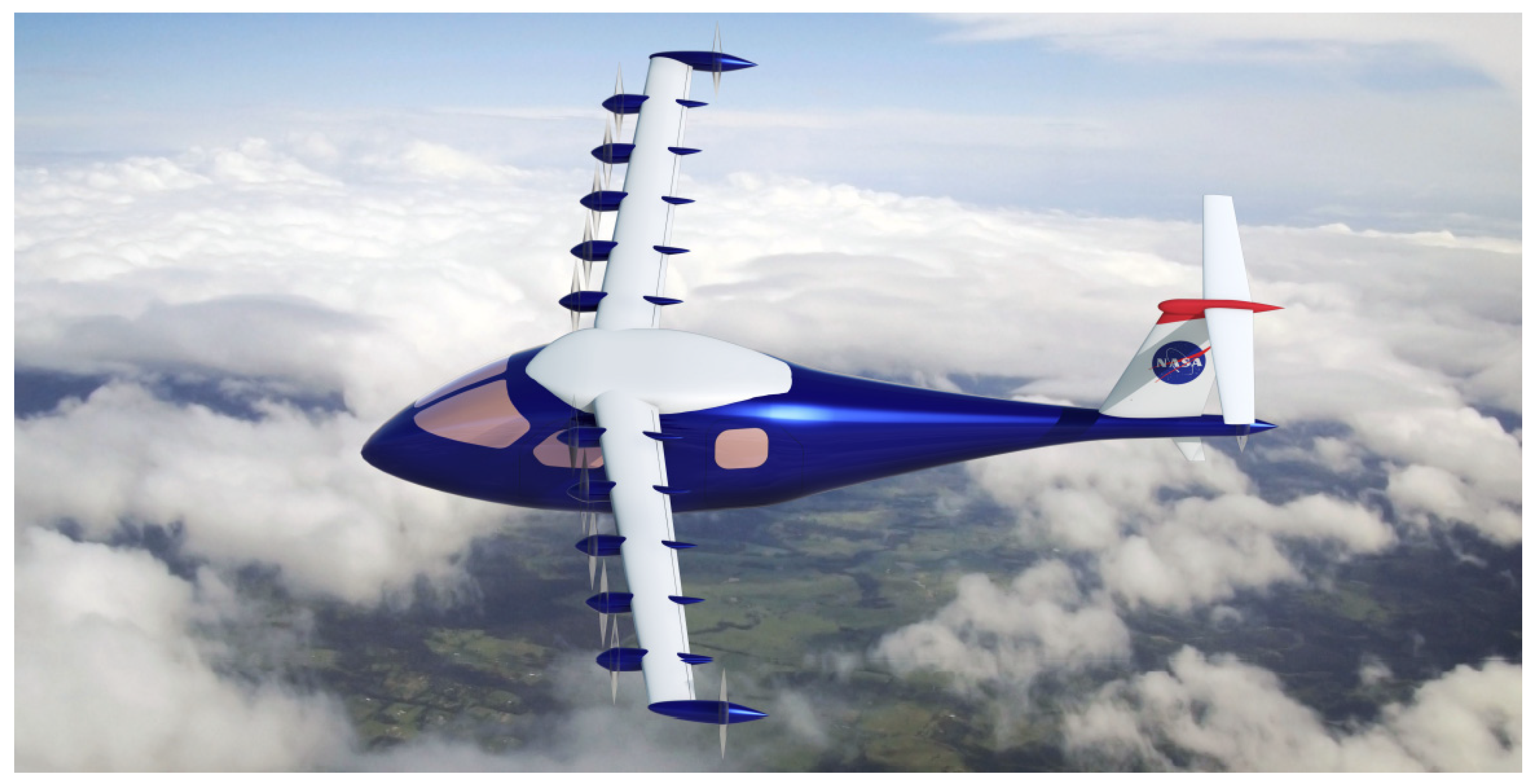
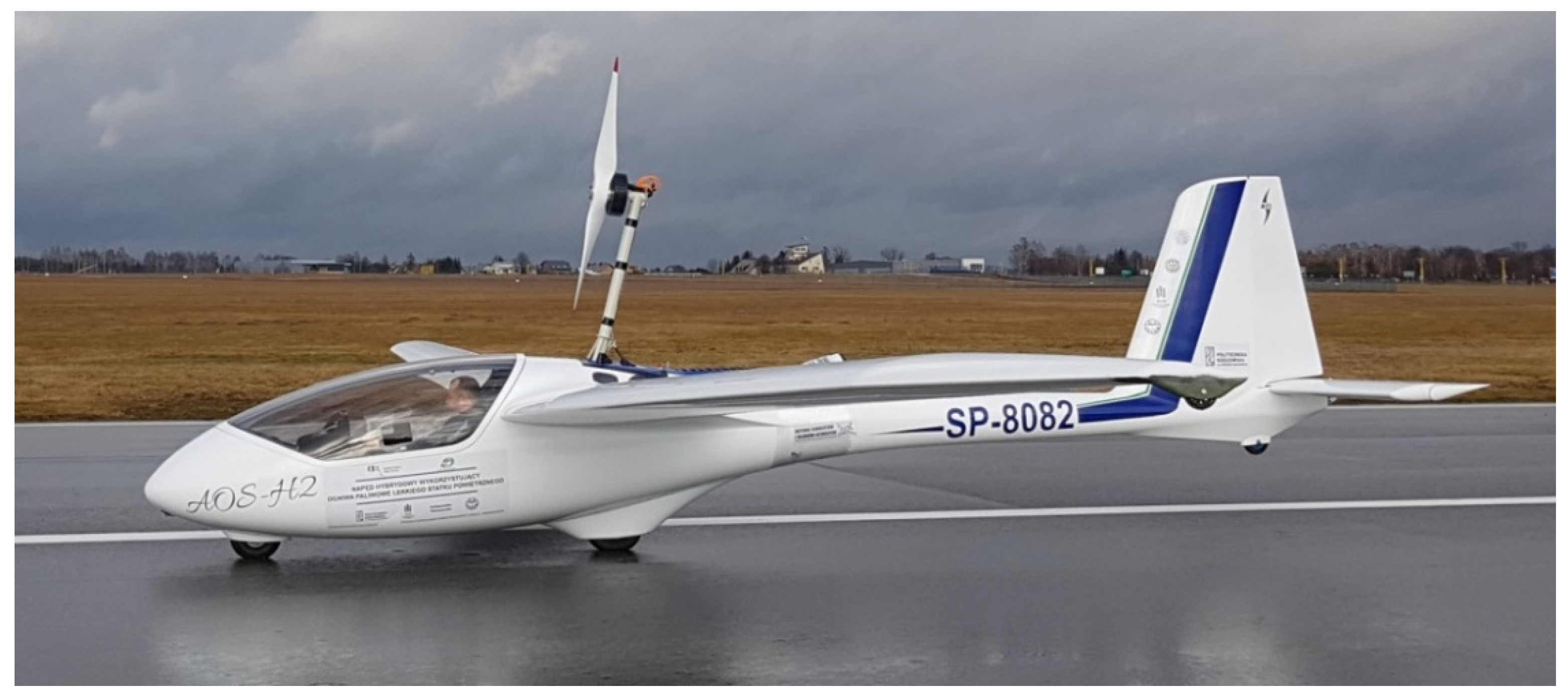


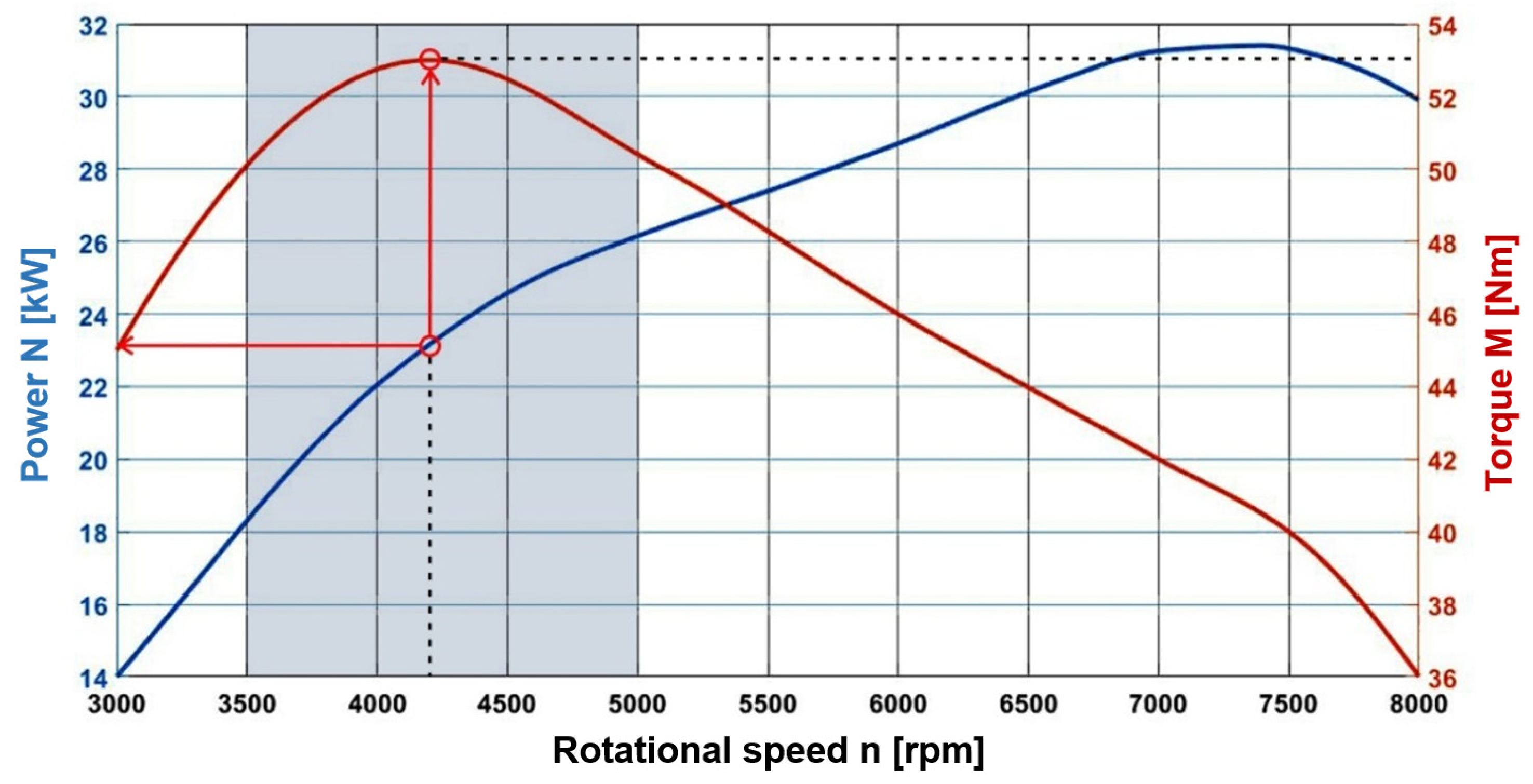

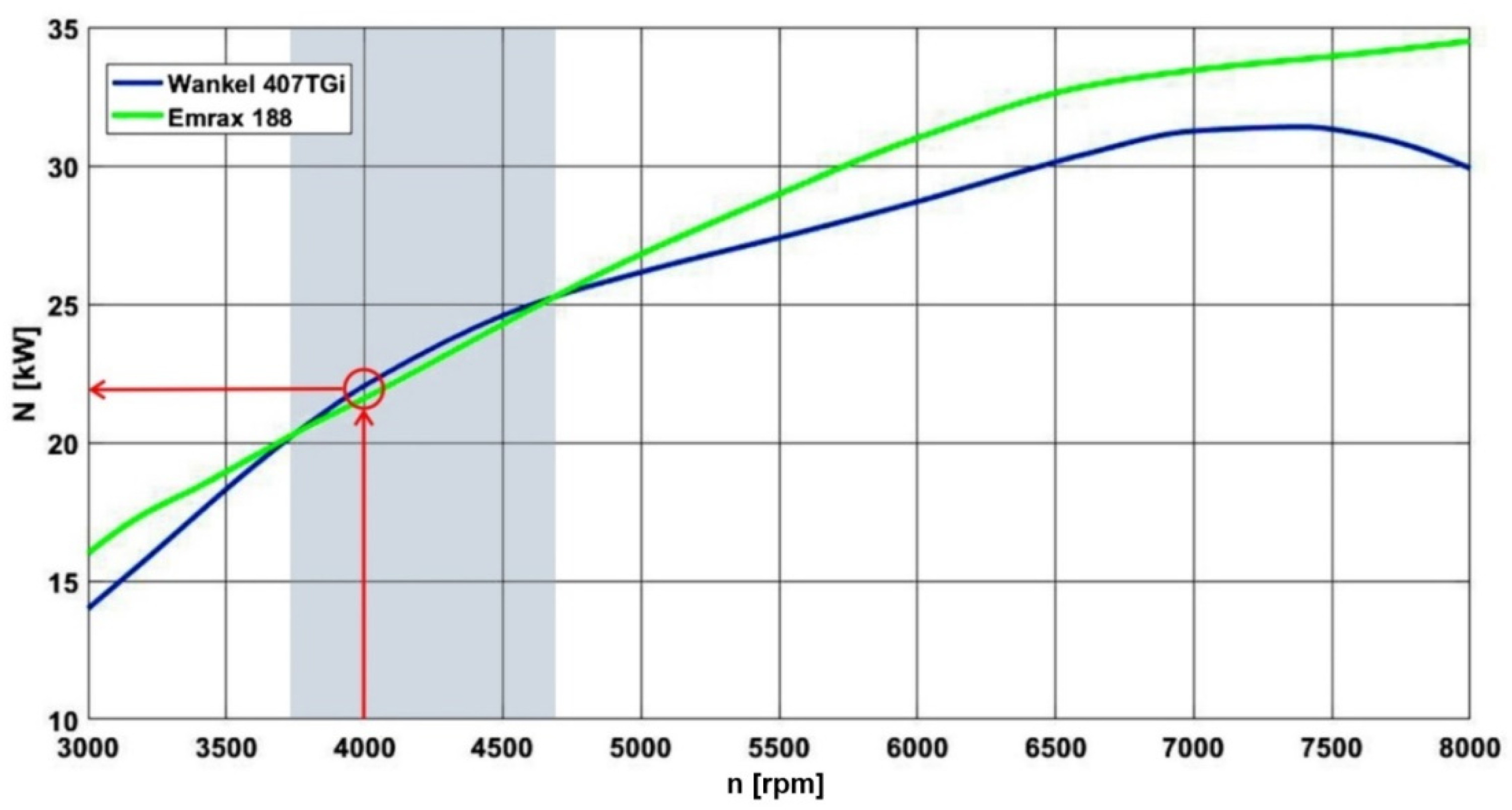
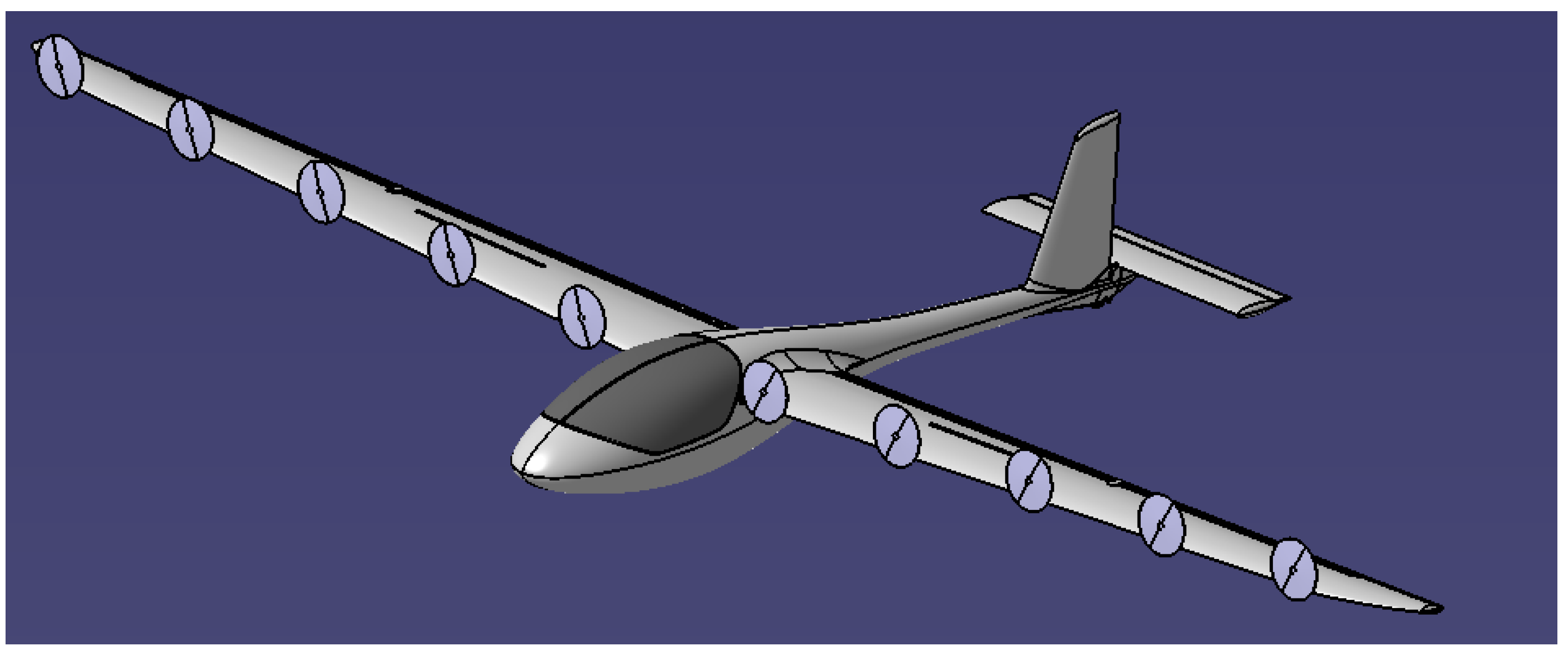

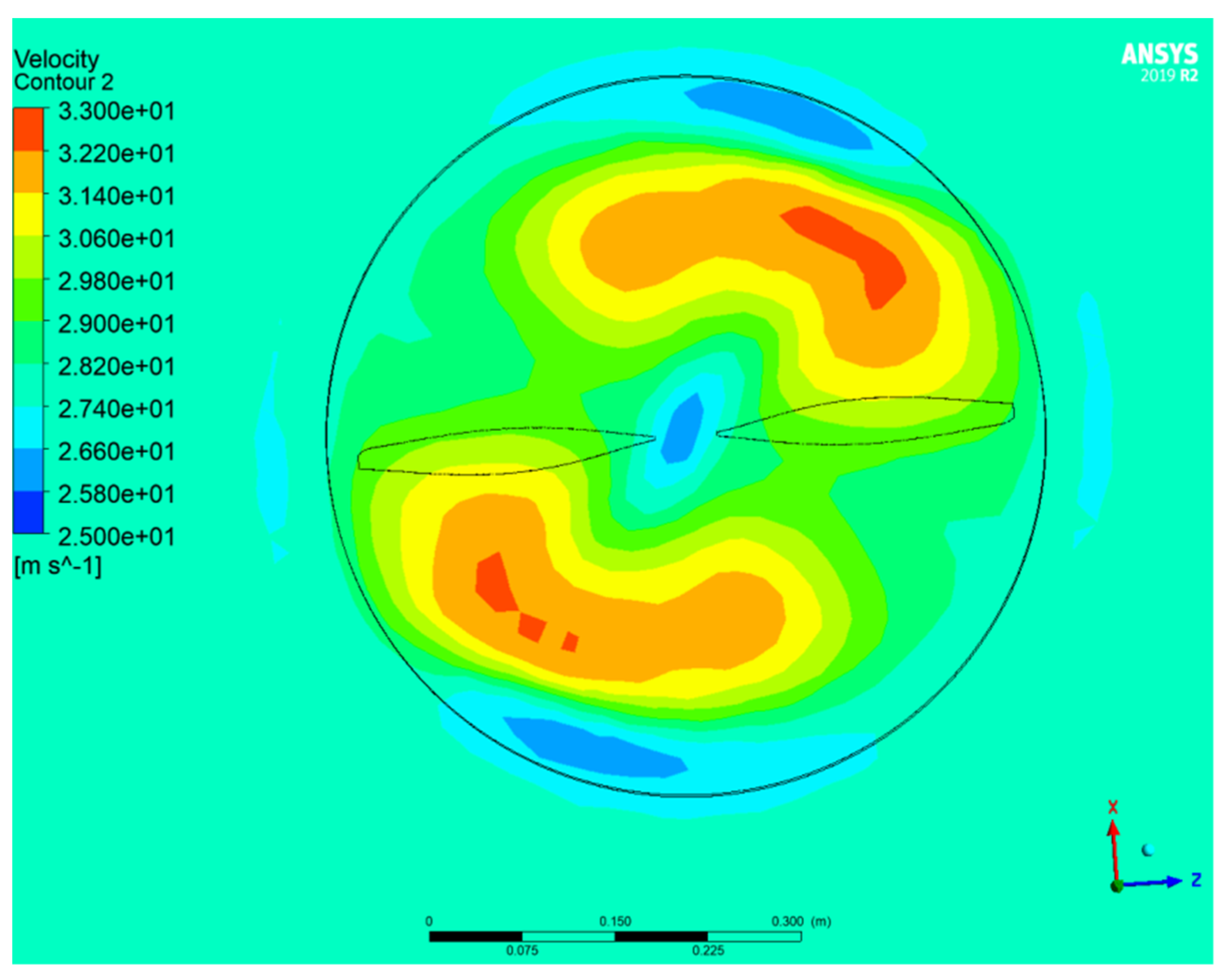


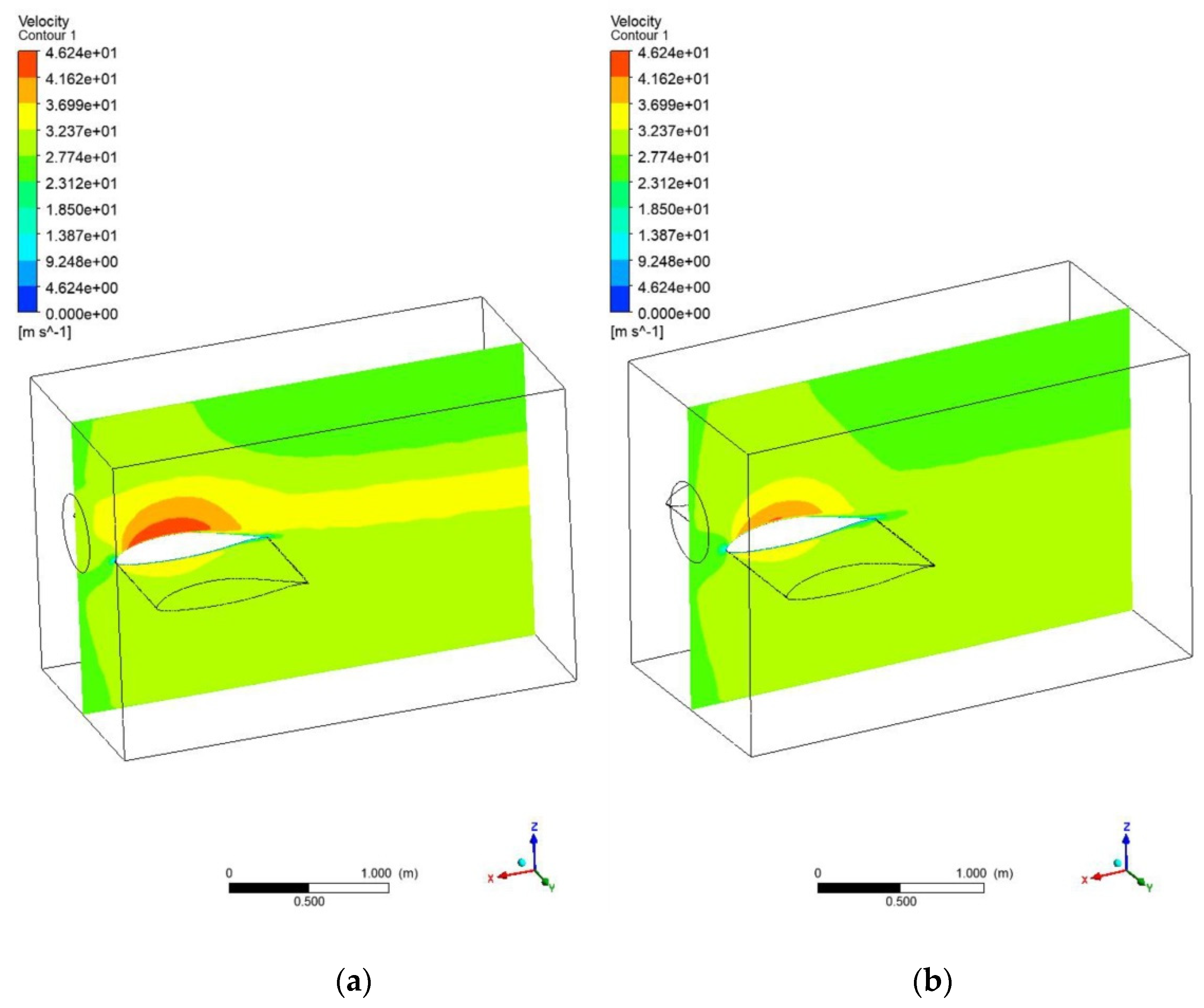


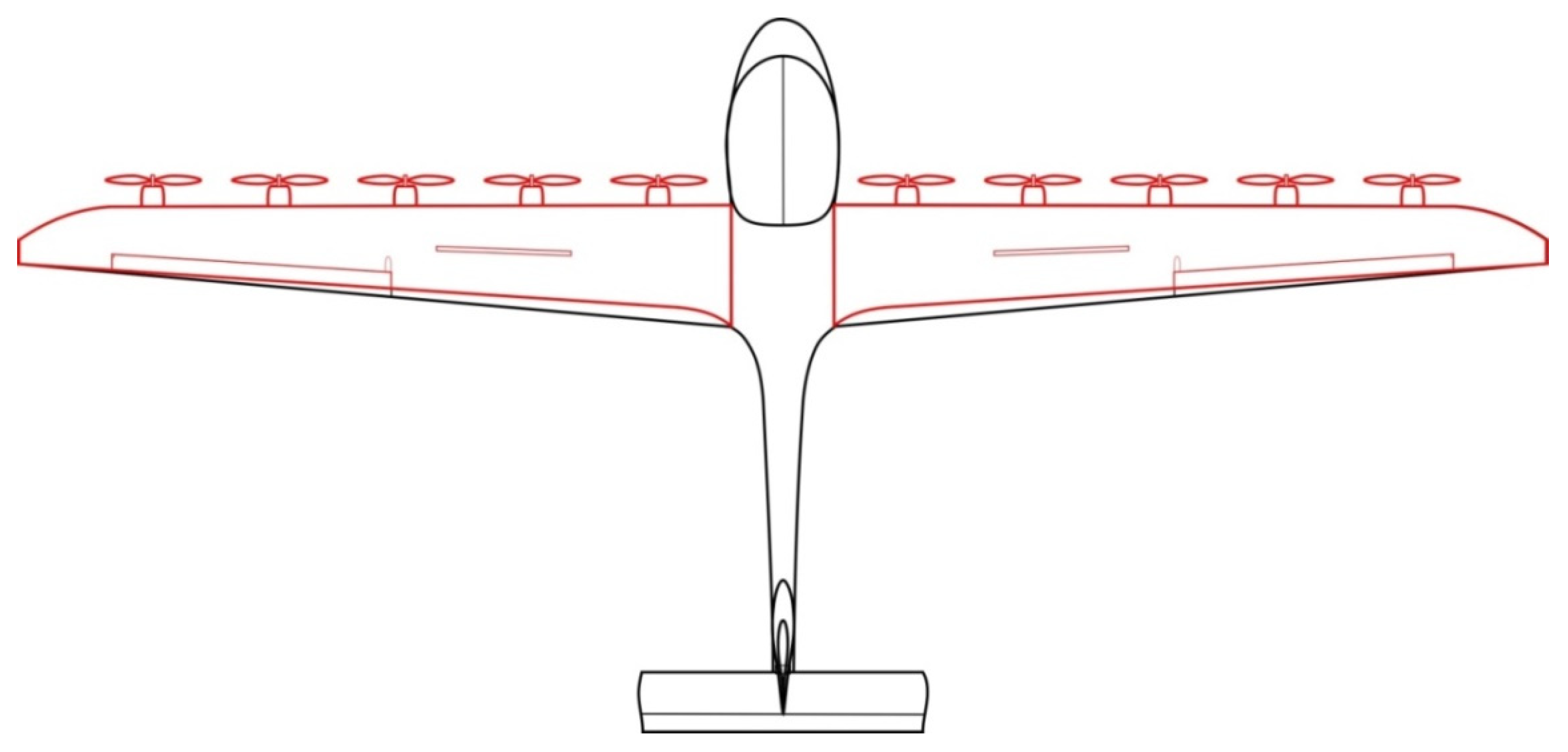

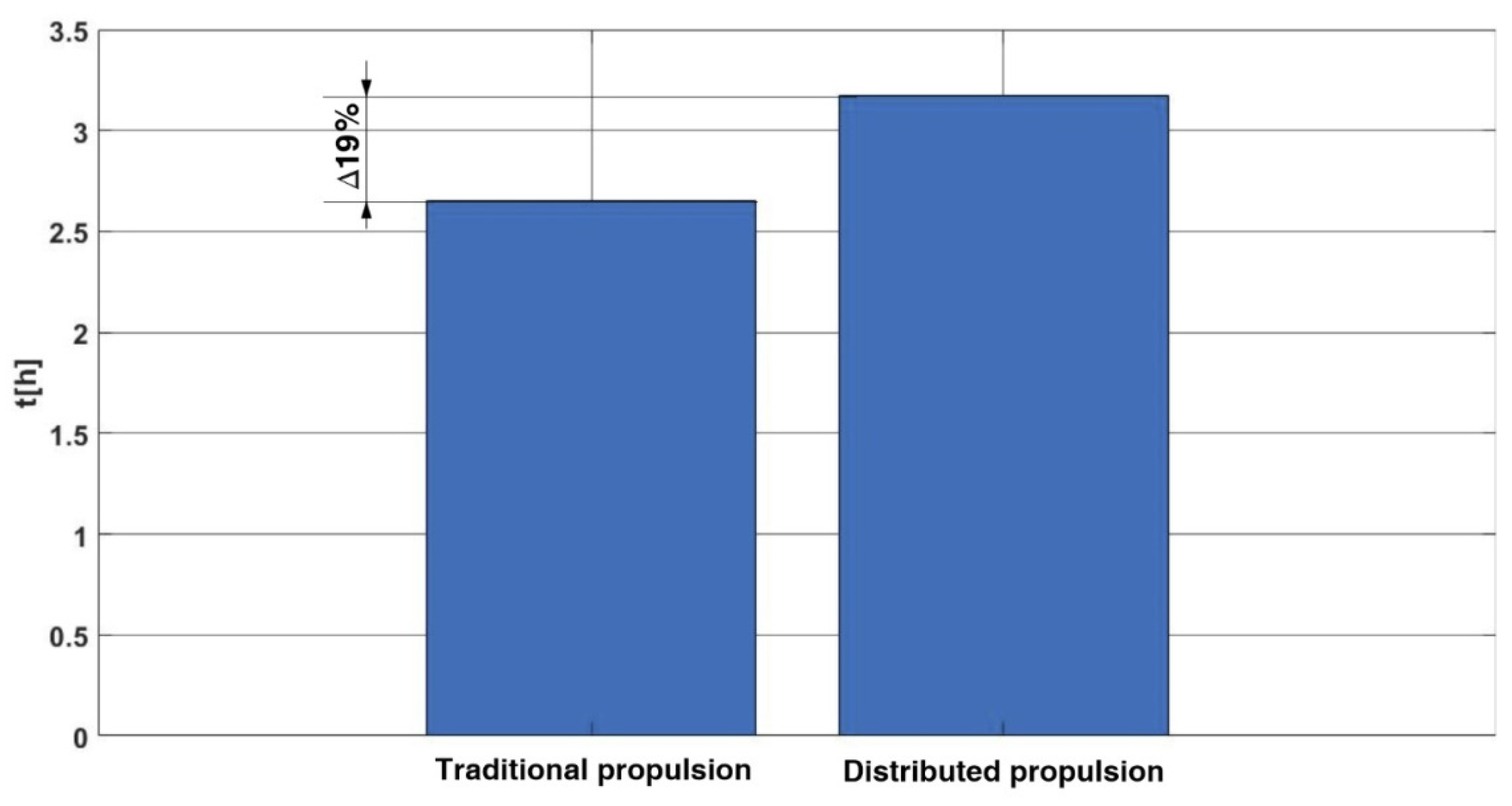
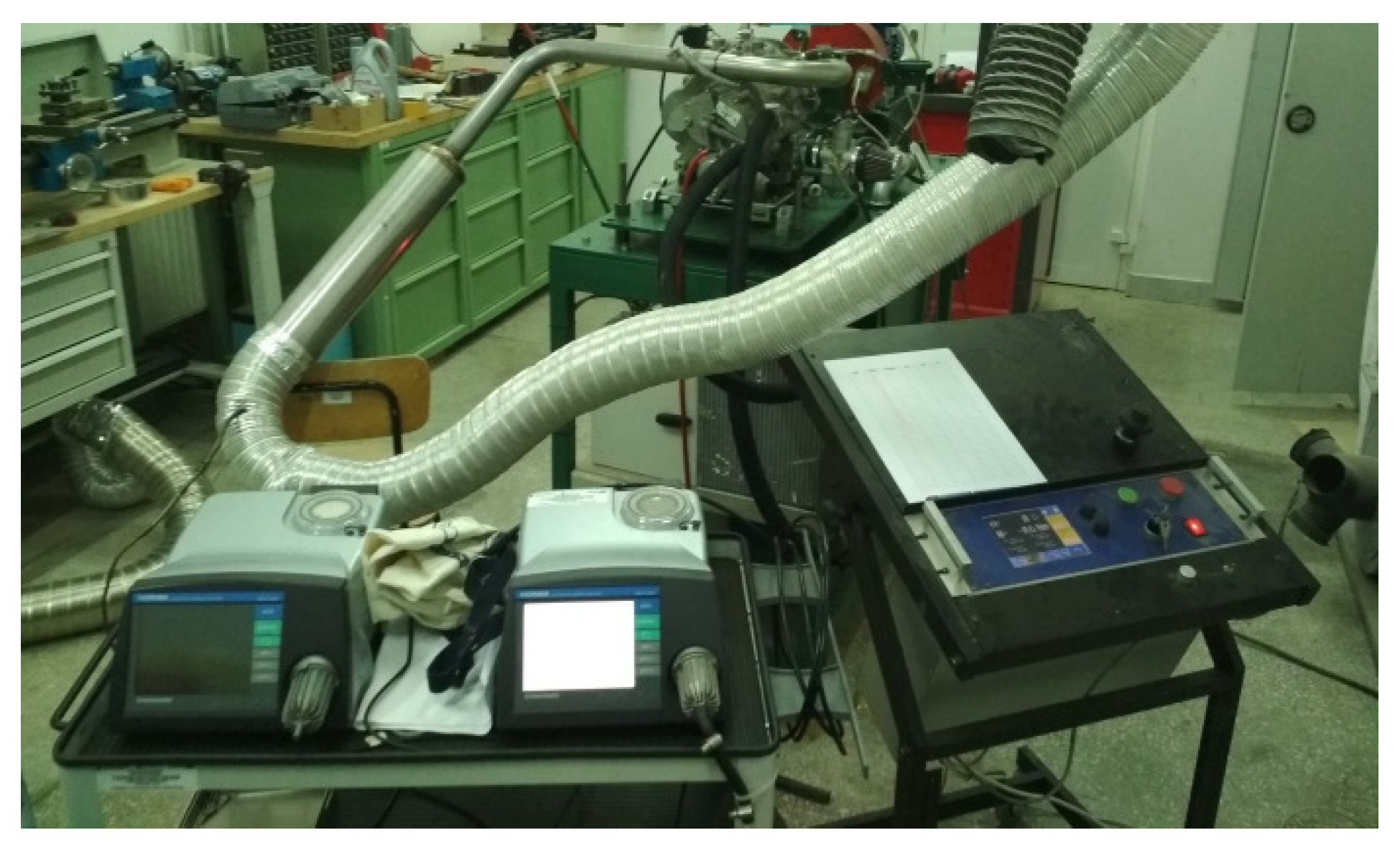

| Wing Area S [m2] | Wingspan B [m] | Aspect Ratio Λ [-] | Aircraft Length l [m] |
|---|---|---|---|
| 15.8 | 16.4 | 17 | 7.64 |
| Combustion Engine | Nmax [kW] | mS [kg] | Elecric Motor | Nconst [kW] | Nmax [kW] | Mconst [Nm] | mS [kg] | Battery Mass [kg] | C [Ah] | Ubat [V] |
|---|---|---|---|---|---|---|---|---|---|---|
| Wankel AG 407 TGi | 32 | 25 | Emrax 188 | 30 | 52 | 50 | 7 | 60 | 16 | 355 |
| Traditional Propulsion | Distributed Propulsion | Δ [%] | |
|---|---|---|---|
| CD | 0.047 | 0.0495 | 5.3 |
| CL | 0.826 | 0.882 | 6.8 |
| NN [W] | PN [N] | ηS | NS [W] |
|---|---|---|---|
| Distributed propulsion variant | |||
| 6110 | 220 | 0.82 | 7451 |
| Traditional propulsion variant | |||
| 7200 | 259.2 | 0.8 | 9000 |
| Traditional Propulsion | Distributed Propulsion | ||
|---|---|---|---|
| Set | Mass [kg] | Set | Mass [kg] |
| Emrax 268 motor | 17 | 10 × AXI 8120 | 10 × 0.675 |
| motor inverter | 7 | 10 × motor regulator | 10 × 0.2 |
| electric installation | 7 | electric installation | 20 |
| mast | 8 | 10 × motor mounts | 10 × 0.7 |
| mast mounting | 2 | balancing system between the energy source and motor regulators | 10 |
| propeller | 4 | 10 × propeller | 10 × 0.1 |
| total mass | 45 | total mass | 45.75 |
| Substance | CO | CO2 | NO |
|---|---|---|---|
| Molar mass [g/mol] | 28.01 | 44.01 | 30.01 |
| Molar volume [dm3/mol] | 22.40 | 22.26 | 22.39 |
| mfuel [kg] | mexh [kg] | λ | ρexh [kg/m3] | Total Vexh [m3] |
|---|---|---|---|---|
| 7 | 72.03 | 0.7 | 0.33 | 218.273 |
| Pollutant Emitted in the Exhausts | CO | CO2 | NO |
|---|---|---|---|
| Pollutant concentration Zpol [%] | 1.9 | 4.4 | 0.0028 |
| Pollutant concentration Zpol [ppm] | 19,000 | 44,000 | 28 |
| Pollutant emission epol [mg/m3] | 23,758.482 | 86,991.914 | 37.529 |
| Mass of a pollutant emitted on the entire route mpol [mg] | 5,185,828.693 | 18,987,962.26 | 8191.613 |
| Mass of a pollutant emitted on the entire route mpol [kg] | 5.186 | 18.988 | 0.0082 |
| erCO [kg/km] | erCO2 [kg/km] | erNO [kg/km] | Ch [kg/h] | |
|---|---|---|---|---|
| Traditional propulsion | 0.020 | 0.072 | 0.000031 | 2.638 |
| Distributed propulsion | 0.016 | 0.060 | 0.000026 | 2.210 |
| Δ [kg/km], [kg/h] | 0.004 | 0.012 | 0.000005 | 0.428 |
Publisher’s Note: MDPI stays neutral with regard to jurisdictional claims in published maps and institutional affiliations. |
© 2022 by the authors. Licensee MDPI, Basel, Switzerland. This article is an open access article distributed under the terms and conditions of the Creative Commons Attribution (CC BY) license (https://creativecommons.org/licenses/by/4.0/).
Share and Cite
Kuźniar, M.; Pawlak, M.; Orkisz, M. Comparison of Pollutants Emission for Hybrid Aircraft with Traditional and Multi-Propeller Distributed Propulsion. Sustainability 2022, 14, 15076. https://doi.org/10.3390/su142215076
Kuźniar M, Pawlak M, Orkisz M. Comparison of Pollutants Emission for Hybrid Aircraft with Traditional and Multi-Propeller Distributed Propulsion. Sustainability. 2022; 14(22):15076. https://doi.org/10.3390/su142215076
Chicago/Turabian StyleKuźniar, Michał, Małgorzata Pawlak, and Marek Orkisz. 2022. "Comparison of Pollutants Emission for Hybrid Aircraft with Traditional and Multi-Propeller Distributed Propulsion" Sustainability 14, no. 22: 15076. https://doi.org/10.3390/su142215076
APA StyleKuźniar, M., Pawlak, M., & Orkisz, M. (2022). Comparison of Pollutants Emission for Hybrid Aircraft with Traditional and Multi-Propeller Distributed Propulsion. Sustainability, 14(22), 15076. https://doi.org/10.3390/su142215076





